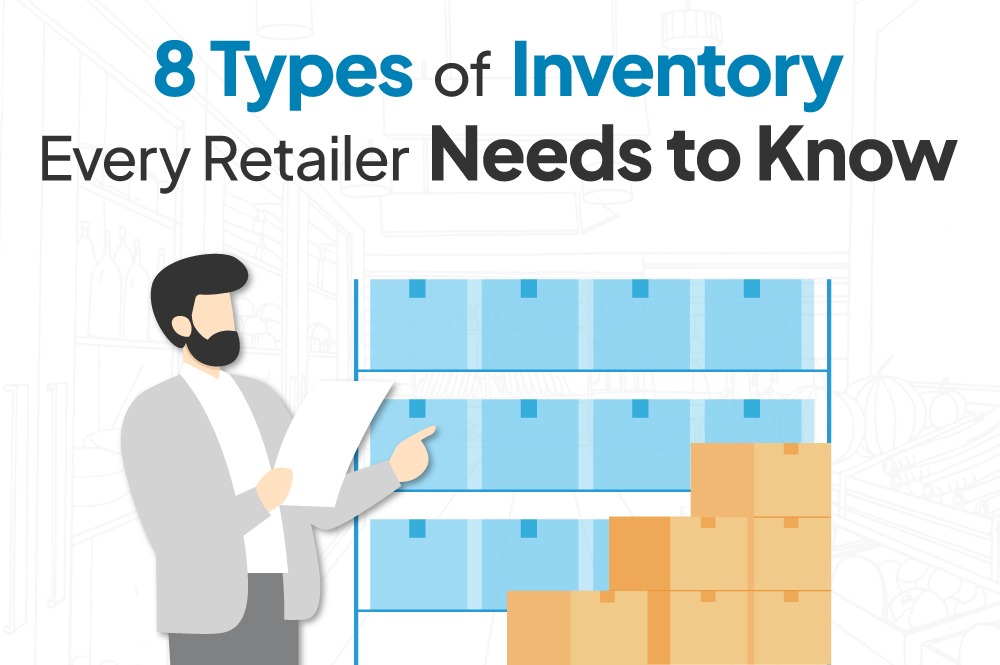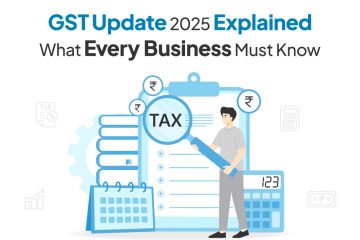8 Types of Inventory Every Retailer Needs to Know
October 25, 2024

When you run a retail business, you not only have to manage the stocks that you sell but also other inventory items that help you operate the retail stores or optimize your inventory management game. For instance, if you sell gifts, you will also need packing material as a subsidiary inventory that is not your primary inventory but helps you run the gifts shop retail business.
Also, if you run a mobile retail store and you predict a new mobile model that is going to be launched shortly will be in high demand. You will have to buy anticipation inventory to optimize your inventory strategy. This will make you a preferred destination for mobile phones, as your customers will know that you always have the stock.
Powerful retail inventory management is possible only when you know what types of retail inventory you should stock, store, and manage. If you are a retailer and want to beat your competition and scale your business, the first step is to upscale your inventory management game. And start with knowing the types of inventory.

Retailers must acquire and keep on hand the raw materials necessary for their in-house manufacturing of certain items or for customization purposes before selling those products.
For instance, a bridal store retailer will have to keep Fabrics (silk, satin, lace), beads, sequins, threads, and zippers as raw material or a designer boutique will have to store fabrics, buttons, zippers, embellishments, threads for customizing dresses as per consumer preference. For a cake shop, the inventory that we count as raw material will be Flour, sugar, eggs, butter, cream, chocolate, flavoring agents, and baking powder. Similarly, jewelry sellers need to keep valuable metals and gems as basic materials for designing completed jewelry pieces.
Proper storage or stocking of raw materials is important for a profitable retail business. Proper stocking ensures that raw materials are always available when needed, preventing production delays. On the other hand, appropriate storage helps maintain the quality and integrity of raw materials.
Learn more about complete guidance on how to manage inventory in retail stores
Retailers need to have an inventory management system that monitors real-time raw material stock levels to ensure timely replenishment. It must have features to set reorder points to automate the purchase of raw materials when levels drop below a certain threshold. Tracking batches or lots of raw materials to manage expiration dates is also important. It must also have a feature for material consumption tracking to analyze consumption patterns to forecast future needs and optimize ordering.
Finished goods refer to products that are fully manufactured and ready for sale to customers. They are critical for retailers as they represent the end products that generate revenue.
For a bookstore retailer books, magazines, journals, e-books, and stationery items are finished goods. For a car accessories retailer Car seat covers, stereo systems, floor mats, GPS devices, and car chargers are finished goods. Similarly for a mobile retailer, mobiles, chargers, mobile covers, screen guards, tuffen glasses, data cables, etc. are directly saleable items and therefore categorized as finished goods.
Ensuring that finished goods are ‘always in stock’ to meet customer demands is key to maintaining customer satisfaction and repeat business. It also helps avoid the embarrassing “out of stock” scenario, which can drive customers to seek alternatives elsewhere. The stockouts of certain products in offline stores is one of the main reasons why rest of the Indian consumers opt for online shopping, PWC report 2023.
If you don’t have a mechanism or system for managing finished goods, you may be tying up valuable storage space and paying higher holding costs. An organized retail inventory management process ensures that finished goods are sorted, categorized, stored, and tracked efficiently.
Inventory systems can identify slow-moving or dead stock and persuade retailers to run special deals to clear out inventory. Similarly, inventory management systems like VasyERP can identify best-selling items and automate the reordering process to ensure that best-selling items are always in stock.
Partially finished goods that are currently undergoing the manufacturing process but have not yet been completed are known as work-in-progress (WIP) inventory. This type of inventory is crucial for retailers involved in the production or assembly of goods, ensuring that the production process runs smoothly without interruptions.
For example, in a furniture store, WIP inventory might include partially assembled tables, chairs, or cabinets. In a Sweet Shop, it could be dough being prepared or sweets that are being prepared in the kitchen. Similarly, if you are into ecommerce retail of toys, and you haven’t assembled the parts into a full-fledged toy, then those parts will be your work-in-progress inventory (as you cannot deliver before assembling).
Proper management of WIP inventory is essential to maintain production efficiency and meet customer deadlines. For example, if you are a sweet store owner and have recently got an order of 500 Kg of sweets for a big function, then you need to track and oversee the WIP inventory to ensure you don’t miss the deadline.
The inventory management system enables the tracking of work-in-progress (WIP) items’ journeys through various production phases. Retailers have a clear view of the production stage from raw materials to consumption to currently processed stocks to avoid delivery delays.
This type of inventory is essential for retailers who source products from different locations or supply their stores from a central warehouse. Similarly, items that are again being delivered to customers and are on the way (sold but not reached customers) will fall under the transit inventory category.
For instance, a clothing or garment retailer might have transit inventory that includes shipments of new seasonal clothing being transported from the manufacturer to various retail outlets. An electronics retailer could have transit inventory consisting of the latest gadgets being shipped from a distribution management system center to multiple stores. Similarly, a grocery retailer might have perishable items like fruits and vegetables in transit from farms to stores. While the items already purchased are now of retailer, but yet haven’t reached their final selling point.
Effective management of transit inventory ensures that goods arrive on time. It is a part of the supply chain dynamics of multi-store and multi-location retail management.
An inventory management system provides real-time tracking of shipments, (batch-tracking), estimated arrival times, and updates on any delays or issues. It also integrates with the retailer’s POS system to automatically update stock levels upon arrival.
Buffer inventory, also known as safety stock, is the surplus inventory that retailers maintain to safeguard against unpredictable variations in supply and demand. This stock acts as a cushion to manage sudden supplier delays or unexpected spikes in customer demand.
For example, pharmacies need to have extra quantities of essential medicines to meet patient needs even if deliveries are delayed. Likewise, a clothing store might keep additional stock of popular items during peak seasons to avoid stockouts. Similarly, an electronics store might keep additional units of high-demand gadgets like smartphones or laptops to prevent stockout or short-supply situations.
Proper management of buffer inventory is crucial to maintaining a balance between having enough stock to meet unexpected demands and minimizing holding costs. Retailers need to calculate the optimal amount of buffer inventory based on historical sales data, lead times, and service level targets.
An effective inventory management system should include features to set and adjust buffer stock levels based on real-time data and predictive analytics. It should also provide alerts when inventory levels fall below the buffer threshold, prompting timely reordering to prevent stockouts.
Anticipation inventory involves stocking up on products in advance of expected increases in demand. This type of inventory is often used to prepare for seasonal sales, promotions, or anticipated market trends ((festivities, lockdowns, pandemic situations, logistics disruptions, road closures, seasonal surges, or even a viral trend that is increasing the demand, etc.)
For instance, a toy retailer anticipates increased demand ahead of children’s day, festival season, or summer holiday. This anticipation will prompt him/her to stock more items than usual to be ready to meet the demand spike. A fashion retailer could stock up on summer apparel in anticipation of the warmer months or a new dressing trend that is picking up on Instagram. Similarly, an electronics retailer might increase inventory of new product releases in anticipation of high initial demand (ex: iPhone new version euphoria).
Managing anticipation inventory requires accurate demand forecasting and planning. “One of the biggest challenges is making a wrong demand forecasting,” states a Cin7 article on the Anticipation Inventory.
Retailers must have a process or system to analyze market trends, historical sales data, and upcoming events to determine the right amount of inventory to hold. Also, keep an eye on competitors, the retail industry, and the market in general to gauge trends before it is too late.
A good inventory management system must support and have features for demand forecasting and trend analysis for stock demand anticipation.
Maintenance, Repair, and Operations (MRO) goods are items used to support the production process and maintain business operations. These goods are not part of the finished products and are not meant for sale, but are essential for the smooth functioning of the business.
All retail stores have MRO inventory that includes office supplies, cleaning products, seating items, repair kits, furniture pieces, and maintenance tools. While these items are not part of the core inventory, they are essential for smooth and uninterrupted daily retail operations. For instance, who will visit your garment showroom if you don’t keep it clean? You need to have cleaning products, toiletries, room fresheners, etc. to keep your store hygienic, germ-free, and odor-free. These items also need a regular supply.
Proper management of MRO inventory ensures that necessary supplies are always available, minimizing downtimes or unpleasant situations. Netsuite suggests performing regular stock audits in retail stores to manage MRO inventory.
An inventory management system for MRO goods should include features for tracking usage, setting reorder points, and managing supplier relationships. It should also provide insights into consumption patterns to help retailers optimize their MRO inventory levels and reduce unnecessary stock.
Cycle inventory refers to the portion of inventory that a retailer cycles through to meet regular demand over a specific period. This type of inventory is ordered and replenished on a regular basis to maintain a steady supply of goods.
For example, a grocery store might have a cycle inventory consisting of daily essentials like bread, milk, and eggs that are ordered and restocked frequently (say every day or in two to three days). Similarly, a hardware store might cycle through inventory of frequently purchased items like nails, screws, and tools. Managing cycle inventory effectively involves setting up frequencies of reorders and onboarding reliable suppliers.
An inventory management system that can automate reorders with set frequencies and intervals can help in the timely replenishment of cycle inventory.
Note: Do not confuse cycle inventory with cycle counting inventory. Cycle counting inventory is a way of retail stock audit or verification of physical inventory.
Understanding the type of inventory you possess helps you exercise improved inventory control and smarter inventory management practices. You should know the variations in inventory to prioritize their management. Raw materials and finished goods are more important than MRO items and therefore, your efforts must be directed accordingly. Inventory controlled and managed using an inventory management system is one of the best methods that smart retailers practice.
Specialized inventory management software like VasyERP can help retail businesses manage all types of retail inventory discussed in the article. The retail inventory system by VasyERP comes with integrated modules for POS, accounting, CRM, and Omnichannel ecommerce to give retailers an all-in-one solution to manage their businesses

GST Update 2025 revolutionizes taxation with only two s...
September 5, 2025

GST 2.0 compliance is becoming a major concern for reta...
September 11, 2025
